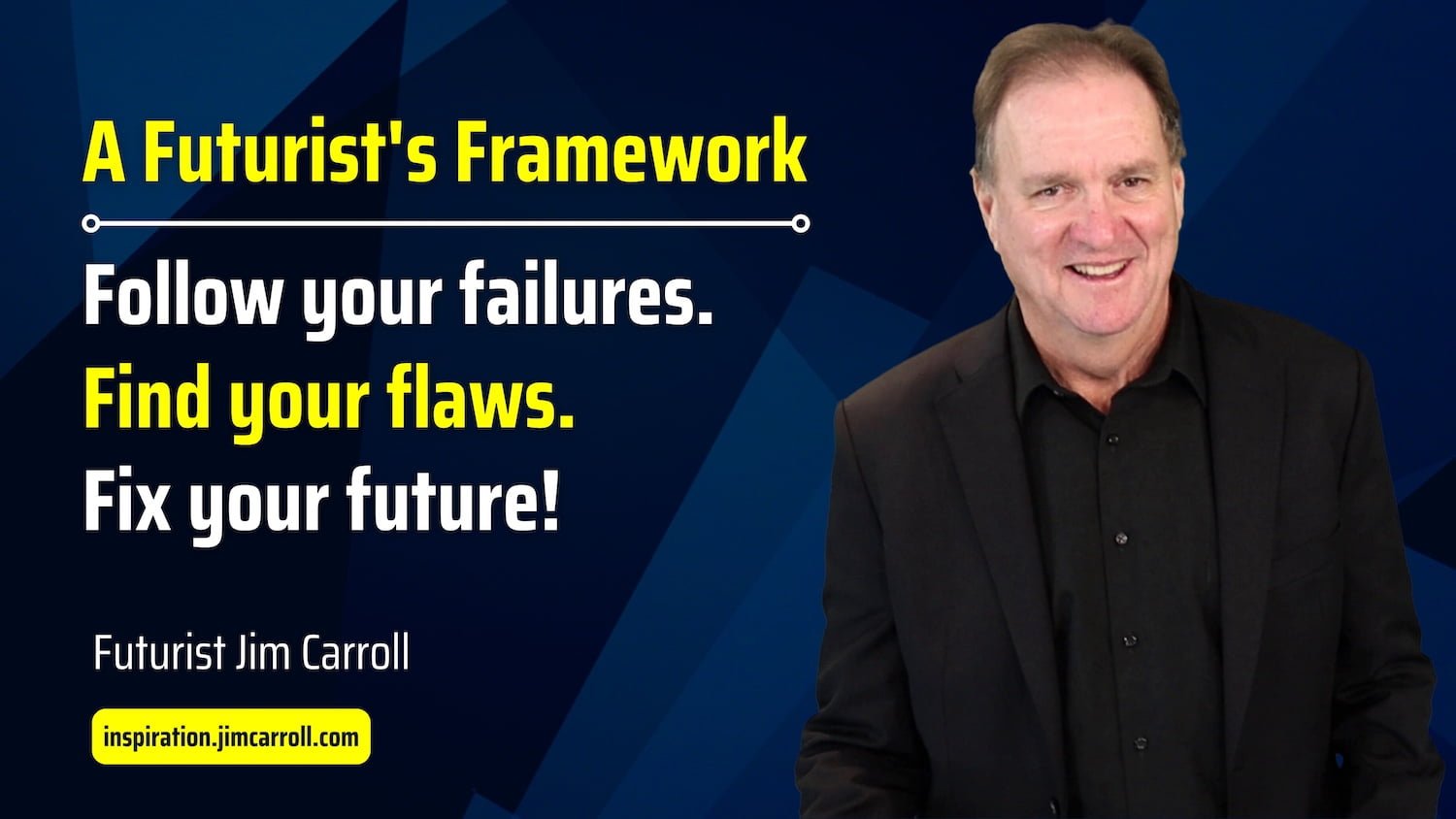“A Futurist’s Framework: Follow your failures. Find your flaws. Fix your future!” – Futurist Jim Carroll

Find the things that are wrong in order to make things right!
Huh?
Let’s say that “innovation” has become a keyword for your organization and your team. If that’s the case, where do you start? Maybe it isn’t with chasing the latest, greatest hot new idea, or by chasing the shiny new toy. Often, it can come from addressing your internal failures, finding your flaws, probing your problems, negotiating your weak points, and managing your challenges. You might get more bang for the buck if you think about innovation as the “fixing of problems.”
That’s why a mindset shift is critical – innovation need not be strictly the development of new products or services; there’s plenty of opportunity to be had by focusing on existing business methods, processes, structure, and methodologies. One of the easiest ways to find opportunities for innovation is by looking for the things that are “broken,” and figuring out how to fix them! For example:
- Look for your blind spots. Where are you lacking information which leads to missed opportunities in your marketplace, failure to provide stellar customer service or excessive operating costs? What trends took you by surprise simply because you’ve got a broken ‘trends radar.’ What issues took you by surprise that you later admitted you should have known about? Undertake a simple “information inventory,” with the idea of identifying where you are lacking in the critical insight you need to be innovative by aligning to trends or operational insight.
- Identify where you have been making decisions while in the dark. As part of the inventory, identify the situations where you’ve missed opportunities, have made the wrong decision, have been misfocussed because you simply had the wrong information, or have had the right information at the wrong time. You could call this your ‘insight deficit.’ That’s one of the first areas that you can focus on for innovative opportunities.
- Highlight your big failures. Where did things really go wrong: where are there excessive issues concerning quality, customer relationships, time to market, or other aspects of your organization where you have simply failed to do what should have been done? Where did your team fail to pursue obvious opportunities? If you take the time to find and confront your biggest foul-ups, you’ll discover plenty of opportunities for innovation.
- Identify the biggest threats. undertake an assessment of the biggest challenges that you might face on a six-month, one-year, and five-year horizon. Where might new competitors emerge? What current shortcomings might cause you to miss opportunities? Where might “blurring” within your industry or market sector occur as a result of continuous product or service evolution?
- Focus on fear. Get scared. Look to your competition for insight on what you might be missing. What is the most innovative thing that they are doing? What levels of risk and creativity are they willing to deal with that you aren’t? What new ideas are out there that you might initially dismiss as being rather flawed and yet might prove to be brilliant? And what is the real impact if you don’t do something drastic right now to catch up or make changes?
- Look for the “lost causes.” Where are you simply wasting a lot of time, doing things that you shouldn’t be doing? For example, do you have a sales force that spends more time looking for information and insight into specific customers than they do selling to those customers? A marketing team that is still focused on fighting the brand wars of yesterday as opposed to the ridiculously fast-changing consumer preferences of today? Where are you simply spending too much time undertaking futile activities?
- Identify resource-leakage. Where is valuable talent being unnecessarily diverted? Is your management team constantly fighting fires, rather than focusing on strategy and opportunity? Do you have a customer service staff that is busy putting data into twelve different databases, rather than fixing customer problems? Take the time to figure out where you are wasting a lot of valuable time doing things you shouldn’t be doing.
- Pinpoint your weaknesses. List the things you can’t do, but that you should be able to do. Where can you see shortcomings in your capabilities compared to the competition or high fliers in other industries? Who are you losing business and employees to and why? And what could you be doing differently to avoid these problems?
- Find your routines, and break them. What are you doing that is absolutely, positively ridiculous – but you keep on doing it because you’ve always done it that way?
It’s not easy to do an inventory of finding things that are wrong in order to figure out how to do things right. And yet, innovative organizations are full of people who dare to take on the organizational sacred cows, the institutional wreckage, the corporate canaries in the coal mine.
They don’t fall into the mindset of ‘we dare not speak the truth’ to one that reminds everyone that ‘the truth shall set us free.’




GET IN TOUCH
Jim's Facebook page
You'll find Jim's latest videos on Youtube
Mastodon. What's on Jim's mind? Check his feed!
LinkedIn - reach out to Jim for a professional connection!
Flickr! Get inspired! A massive archive of all of Jim's daily inspirational quotes!
Instagram - the home for Jim's motivational mind!